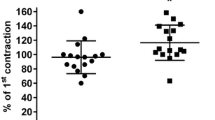Summary
Hexoprenaline is aβ-adrenergic agent used for tocolysis after the 26th week of pregnancy. The purpose of the present study was to demonstrate the site of action of hexoprenaline on the membrane of single isolated smooth muscle cells. The main action ofβ-mimetics on the cell is hyperpolarization of the cellular membrane, i.e.β-mimetics have similar effects as K+-ions (Standen et al., 1989). Our results indicate a prolonged and significantly enhanced activity of K+-channels in the cell membrane, as may also be demonstrated by the use of the K+-channel activator Calcitonin-gene related peptide (CGRP). In control experiments under physiological conditions, we observed a large conductance K+-channel with 158 pS. The channel was voltage dependent and Ca++ sensitive indicating that it belongs to the class of big conductance Ca++-activated K+-channels (BKCa). Hexoprenaline and CGRP both increased the open probability (Po) of the channel measured with the patch clamp system in the cell attached configuration. Hexoprenaline was also an activator of the BKCa in the presence of Nitrendipine, indicating that the activation of the Ca++ sensitive channel is not an indirect effect of Ca++ currents via L-type Ca++ channels.
Similar content being viewed by others
References
Boyle MB, MacLunsky NJ, Naftolin F, Kaczmarek LK (1987) Hormonal regulation of K+-channel messenger RNA in rat myometrium during oestrus cycle and in pregnancy. Nature 330, 373–375
Driska SP, Porter R (1986) Isolation of smooth muscle cells from swine carotid artery by digestion with papain. Am J Physiol 251: C474–481
Hamill OP, Marty A, Neher E, Sakmann B, Sigworth FJ (1981) Improved patch-clamp techniques for high resilution current recording from cells and cell free membrane patches. Pflugers Arch 391:85–100
Klöckner U, Isenberg G (1985) Action potentials and net membrane currents of isolated smooth muscle cells (urinary bladder of the guines pig) Pflugers Arch 405:329–339
Mahnert W, Schreibmayer W, Adelwöhrer NE, Tritthart HA (1992) Three types of Potassium channels exist at least in the membrane of human myometrial cells. Biophys J 61 (22):A252
Nelson MT, Huang Yu, Brayden JE, Hescheler J, Standen NB (1990) Arterial dilatations in response ton calcitonin gene-related peptide involve activation of K+-channels. Nature 344:770–773
Silberberg SD, Poder TC, Lacerda AE (1989) Endolthelin increase single-channel calcium currents in coronary arterial smooth muscle cells. Federation of wuropean biochemical societies 247:68–72
Standen NB, Quayle JM, Davies NW, Brayden JE, Huang Y, Nelson MT (1989) Hyperpolarizing vasodilators activate ATP-sensitive K+-channels in arterial smooth muscle. Science 245:177–180
Tritthart HA, Mahnert W, Fleischhacker A, Adelwöhrer N (1991) Potassium channels and modulating factors of channel function in the human myometrium. Z Kardiol 80 [Suppl.] 7:29–33
Author information
Authors and Affiliations
Rights and permissions
About this article
Cite this article
Adelwoehrer, N.E., Mahnert, W. Hexoprenaline activates potassium channels of human myometrial myocytes. Arch Gynecol Obstet 252, 179–184 (1993). https://doi.org/10.1007/BF02426355
Received:
Accepted:
Issue Date:
DOI: https://doi.org/10.1007/BF02426355




